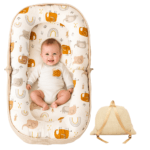Getting a good night’s sleep during pregnancy can be a real challenge. As your body changes and your baby grows, finding a comfortable sleeping position becomes increasingly difficult. This is where a pregnancy pillow can make a world of difference. Designed to provide support where you need it most, these pillows can help alleviate common pregnancy discomforts such as back pain, hip pain, and heartburn. Whether you’re a side sleeper, back sleeper, or constantly switching positions, there’s a pregnancy pillow out there to suit your needs.
In this guide, we’ll share top tips on how to sleep with a pregnancy pillow, ensuring you get the restful, rejuvenating sleep you need. From choosing the right type of pillow to finding the perfect sleeping position, we’ve got you covered. Say goodbye to restless nights and hello to sweet dreams with the help of these pregnancy pillow tips.
Importance of Quality Sleep During Pregnancy

Quality sleep during pregnancy is crucial for the mother and the developing baby. As your body works overtime to support the growing life inside you, adequate rest becomes essential for maintaining your health and well-being. Here’s why quality sleep is so important during pregnancy:
Physical Health
Proper rest helps your body cope with pregnancy’s physical changes and demands. It supports immune function, reduces the risk of infections, and aids in the body’s repair and recovery processes. Additionally, good sleep can help manage pregnancy-related aches and pains, such as back pain and joint discomfort, by promoting muscle relaxation and healing.
Emotional Well-being
Hormonal fluctuations during pregnancy can lead to mood swings and heightened emotions. Quality sleep plays a vital role in emotional regulation, helping to reduce stress and anxiety. A well-rested mind is better equipped to handle pregnancy’s emotional ups and downs, contributing to a more positive overall experience.
Fetal Development
Your sleep quality directly affects your baby’s development. Restorative sleep optimizes your body, providing your baby with nutrients and oxygen. Poor sleep can lead to complications such as high blood pressure, preeclampsia, and gestational diabetes, all of which can impact fetal health.
Energy Levels
Pregnancy can be exhausting, and good sleep is essential for maintaining energy levels throughout the day. Adequate rest helps you stay active and engaged in daily activities, supporting overall physical and mental health.
Preparation for Labor
Labor and delivery require a significant amount of energy and stamina. Quality sleep during pregnancy helps build up the reserves needed for childbirth, contributing to a smoother labor process.
What are Pregnancy Pillows?

Pregnancy pillows are a game-changer for expectant mothers struggling to find a comfortable sleeping position. As your belly grows and your body undergoes significant changes, traditional pillows may no longer provide the support you need. Pregnancy pillows are specially designed to contour the unique curves of a pregnant body, offering targeted support to critical areas such as the belly, back, and hips. They come in various shapes and sizes, each catering to different needs and preferences.
Whether you’re dealing with back pain or hip discomfort or need extra support to stay in a side-sleeping position, there’s a pregnancy pillow that can help. By providing this essential support, pregnancy pillows can significantly improve sleep quality, reduce pain, and enhance overall comfort. In this guide, we’ll explore the different types of pregnancy pillows, how to choose the right one for you and tips on how to use them effectively to ensure you get the restful sleep you deserve.
Types of Pregnancy Pillows

Pregnancy pillows come in various shapes and sizes, each designed to address specific discomforts and provide support where needed most. Here are the main types of pregnancy pillows and their benefits:
Full-Body Pillows
Full-body pillows are long, oversized pillows that run the length of your body. They provide comprehensive support for your head, neck, belly, back, and knees. These pillows are perfect for side sleepers, as they help maintain proper spinal alignment and reduce pressure on your hips and back.
C-Shaped Pillows
C-shaped pillows are designed to wrap around your body in a C-shape, simultaneously supporting your head, neck, belly, back, and legs. They are ideal for those who prefer sleeping on their side, as they help cradle the body and keep the spine aligned. The unique shape also makes it easier to switch sides without losing support.
U-Shaped Pillows
U-shaped pillows provide full-body support by enveloping your body from both sides. These pillows are great for back and side sleepers who need support for their head, neck, back, belly, and legs. The U-shape allows you to turn from side to side without repositioning the pillow, making it perfect for those who move a lot during sleep.
Wedge Pillows
Wedge pillows are more petite, triangular-shaped pillows that offer targeted support. They can be placed under the belly to relieve pressure and lift the abdomen, behind the back to prevent rolling onto your back during sleep, or between the knees to align the hips and reduce lower back pain. Wedge pillows are compact and versatile, making them a great addition to other pregnancy pillows for extra support.
Benefits of Each Type
- Full-Body Pillows: Provide comprehensive support, help with spinal alignment, and reduce hip and back pain.
- C-Shaped Pillows: Cradle the body, support multiple areas at once, and make it easier to switch sides.
- U-shaped pillows: Offer all-around support, perfect for frequently changing positions.
- Wedge Pillows: Provide targeted support, are versatile and compact, and are ideal for use with other pillows.
Is All Pregnancy Pillows Are the Same?
While pregnancy pillows share the overarching purpose of providing support and comfort during pregnancy, they are not all the same. These pillows come in diverse designs, sizes, materials, features, purposes, and brands, each offering unique benefits and catering to different needs and preferences.
Firstly, the design of pregnancy pillows varies widely. Some are full-body pillows that wrap around the entire body, while others are smaller and more targeted in their support. Additionally, the size of pregnancy pillows differs, with some being more compact and others more oversized, impacting their ability to provide comprehensive support.
The material composition of pregnancy pillows varies, ranging from memory foam to polyester fiberfill to microbeads, each offering firmness, support, and breathability. Furthermore, pregnancy pillows may come with additional features such as adjustable inserts, removable covers, or cooling gel inserts, which can enhance comfort and convenience and affect the overall cost.
For Best pregnancy pillows Read our reviews: Leachco Snoogle® Supreme Pregnancy/Maternity Pillow Review 2024
How to Choose the Right Pregnancy Pillow?
Choosing the right pregnancy pillow can significantly affect your comfort and sleep quality during pregnancy. With various types available, it’s essential to consider your personal needs and preferences. Here are some key factors to help you select the perfect pregnancy pillow:
Consider Your Sleeping Position
Your preferred sleeping position is crucial in determining the best pillow for you.
- Side Sleepers: Most pregnancy pillows are designed to encourage side sleeping, which is recommended during pregnancy. U-shaped and C-shaped pillows provide excellent support for side sleepers by cradling the entire body.
- Back Sleepers: If you tend to sleep on your back, a U-shaped pillow can provide support for your head, neck, and back, preventing you from rolling over.
- Combination Sleepers: For those who switch positions frequently, a U-shaped or full-body pillow allows for easy movement while maintaining support.
Assess Your Comfort Needs
Identify the areas where you need the most support:
- Back Pain: If you experience back pain, look for a pillow with substantial back support, like a U-shaped or full-body pillow.
- Belly Support: Your belly needs extra support to reduce strain as it grows. C-shaped and full-body pillows are great for providing belly support.
- Hip and Knee Support: Placing a pillow between your knees can help align your hips and reduce lower back pain. Wedge pillows or full-body pillows can be effective for this purpose.
Think About Versatility
Consider how you might use the pillow beyond pregnancy:
- Postpartum Support: Some pregnancy pillows can double as nursing or provide support while sitting.
- Travel: A smaller, more portable pillow like a wedge might be more convenient if you travel frequently.
- Long-Term Use: High-quality pregnancy pillows can be used for general comfort, not just during pregnancy.
Evaluate Material and Quality
The material and quality of the pillow can impact its comfort and durability:
- Hypoallergenic Materials: Look for pillows made from hypoallergenic materials to avoid allergic reactions.
- Breathable Fabrics: Choose pillows with breathable covers to keep you cool and comfortable throughout the night.
- Washable Covers: Pregnancy pillows with removable, machine-washable covers are easier to maintain.
Read Reviews and Recommendations
Researching reviews and seeking recommendations from other pregnant women can provide valuable insights:
- Customer Reviews: Read reviews to learn about other users’ experiences, focusing on comfort, durability, and support.
- Brand Reputation: Consider brands known for producing high-quality pregnancy pillows.
Budget Considerations
Pregnancy pillows come in a range of prices. While it’s important to stay within your budget, remember that investing in a high-quality pillow can provide significant comfort and support:
- Compare Prices: Look for sales or discounts, but don’t keep quality high.
- Long-Term Investment: A good pregnancy pillow is worthwhile because it can be used throughout your pregnancy and beyond.
How Do I Know If I Need a Pregnancy Pillow?
Here are some key indicators:
- Discomfort While Sleeping: Struggling to get comfortable due to your growing belly or other changes.
- Frequent Back Pain: Experiencing back pain from added weight and shifting center of gravity.
- Hip and Pelvic Pain: Pain in hips and pelvis, especially in the later stages of pregnancy.
- Trouble Staying Asleep: Waking up frequently due to discomfort or needing to reposition.
- Difficulty Finding a Comfortable Position: Getting comfortable as your belly grows is harder.
- Heartburn or Acid Reflux: Dealing with heartburn or acid reflux when lying flat.
- Swollen Legs and Feet: Swelling in legs and feet, needing to elevate them for relief.
- Side-Sleeping Challenges: Struggling to stay on your side, which is recommended during pregnancy.
- Need for Extra Support While Sitting: Discomfort when sitting for long periods.
- Postpartum Comfort: Looking for support and comfort after the baby arrives.
- Personal Recommendations: Suggestions from other expectant mothers or healthcare providers.
How to Use a Pregnancy Pillow?
A full-body pregnancy pillow can provide comprehensive support for expectant mothers, but knowing how to use it effectively is critical to maximizing its benefits. Here’s how to make the most of your full-body pregnancy pillow:
Side Sleeping with a Full-Body Pillow
- Positioning: Start by lying on your side with the pillow running along your body.
- Embrace the Pillow: Hug the top of the pillow with your arms, bringing it close to your chest.
- Knee Support: Place the lower part of the pillow between your knees, ensuring they are aligned with your hips.
- Belly Support: For additional support, you can tuck the front of the pillow under your belly, lifting and reducing strain.
- Adjustments: Experiment with the position and firmness of the pillow until you find the most comfortable arrangement.
Back Support with a Full-Body Pillow
- Positioning: Lie on your side with the pillow behind your back.
- Support: Position the pillow so that it runs along the length of your spine, supporting your back.
- Adjustments: You can adjust the placement of the pillow to provide more or less support, depending on your comfort level.
- Experiment: Try different angles and positions until you find the most comfortable for your back.
Leg Support with a Full-Body Pillow
- Positioning: Lie on your side with the pillow between your legs.
- Alignment: Ensure the pillow is positioned so your top leg is parallel to the mattress and your hips are aligned.
- Knee and Hip Alignment: The pillow should support your top leg, keeping it in line with your hip to prevent strain.
- Comfort: Experiment with the firmness and thickness of the pillow to find the level of support that feels best for your legs.
How to Maintain Your Pregnancy Pillow
Proper maintenance of your pregnancy pillow is essential to ensure its longevity and hygiene. Here are some tips for keeping your pillow clean and in good condition:
- Regular Washing: Check the care instructions provided by the manufacturer and wash your pillow regularly according to those guidelines. Most pregnancy pillows have removable covers that can be machine-washed for easy cleaning.
- Spot Cleaning: For minor stains or spills, spot-clean the affected area using a mild detergent and a damp cloth. Gently blot the stain without rubbing to avoid damaging the fabric.
- Drying: After washing, air dry the pillow or covers thoroughly before putting them back on your pillow. Avoid high heat, as it can damage the fabric or cause shrinkage.
- Fluffing: Fluff your pillow regularly to maintain its shape and supportiveness. This is especially important for pillows filled with shredded memory foam or polyester fiberfill, as they can become compressed over time.
- Storage: When not in use, store your pregnancy pillow in a cool, dry place away from direct sunlight. Avoid folding or compressing the pillow for extended periods, as this can affect its shape and support.
- Replacement: If your pregnancy pillow starts to lose its shape and support or becomes uncomfortable, consider replacing it. Most pregnancy pillows are designed to last throughout your pregnancy and beyond, but regular use can cause wear and tear over time.
- Protective Covers: Consider using a protective cover over your pillow to help extend its lifespan and keep it clean. These covers are usually waterproof and can be easily removed and washed.
Common Challenges and Solutions
Overheating at Night
Challenge: Many pregnant women experience overheating at night, especially during the later stages of pregnancy, due to hormonal changes and increased blood flow.
Solution: To combat overheating:
- Use breathable bedding materials such as cotton sheets and lightweight blankets.
- Opt for moisture-wicking pajamas to help regulate body temperature.
- Keep the bedroom cool by using a fan or adjusting the thermostat to a comfortable temperature.
- Consider using a pregnancy pillow with cooling gel inserts or a removable, washable cover to help dissipate heat.
Pillow Takes Up Too Much Space
Challenge: Pregnancy pillows, especially full-body pillows, can take up a significant amount of space in the bed, making it challenging for you and your partner to find room to sleep comfortably.
Solution: To address this issue:
- Consider using a smaller pregnancy pillow, such as a wedge pillow, which provides targeted support without taking up as much space.
- Position the pregnancy pillow strategically to maximize space in the bed. For example, place it behind you for back support or between your knees for hip alignment.
- Communicate with your partner about your need for extra support and space in bed, and work together to find a solution that works for both of you.
Difficulty in Changing Positions
Challenge: As your pregnancy progresses, changing positions in bed can become increasingly challenging due to discomfort and the bulkiness of pregnancy pillows.
Solution: To make changing positions easier:
- Experiment with different pillow placements to find the most comfortable positions for sleeping and transitioning between them.
- Use smaller, more versatile pregnancy pillows that can be easily repositioned, such as wedge or C-shaped ones.
- Practice gentle stretching and relaxation techniques before bed to help alleviate muscle tension and make changing positions more comfortable.
- Consider investing in a pregnancy pillow with a removable cover or adjustable inserts, allowing you to customize the pillow to suit your changing needs and preferences.
Alternative Uses of Pregnancy Pillows
While pregnancy pillows are primarily designed to provide support and comfort during pregnancy, they can also serve various alternative purposes. Here are some creative ways to use your pregnancy pillow beyond pregnancy:
- Nursing Pillow: Many pregnancy pillows are designed to double as nursing pillows after childbirth. The unique shape and support provided by the pillow can help position your baby comfortably during breastfeeding sessions, reducing strain on your arms and back.
- Body Support: Even if you’re not pregnant, a pregnancy pillow can provide excellent support for your body while sleeping or lounging. Its ergonomic design can help alleviate back pain, hip discomfort, and other common sleep issues, making it suitable for anyone seeking extra comfort and support.
- Reading or Watching TV: Prop up your pregnancy pillow against the headboard or wall to create a cozy reading or TV-watching nook. The pillow’s plushness and support can make extended periods of sitting more comfortable and enjoyable.
- Postpartum Support: Use your pregnancy pillow to support your body as it recovers after childbirth. Whether lying in bed or sitting on the couch, the pillow can provide much-needed comfort and relief postpartum.
- Travel Companion: Bring your pregnancy pillow with you when traveling to ensure comfortable support wherever you go. Whether you’re on a plane, train, or hotel room, the pillow can help you relax and rest more comfortably during your journey.
- Body Pillow for Partners: Share the comfort of your pregnancy pillow with your partner by using it as a body pillow for both of you to enjoy. Its generous size and supportive design make it ideal for cuddling up together for a good night’s sleep.
- Back Support for Sitting: Place your pregnancy pillow behind your back while sitting for extra lumbar support. Whether working at a desk or relaxing on the couch, the pillow can help promote better posture and reduce discomfort.
- Support During Yoga or Meditation: Use your pregnancy pillow as a bolster or support cushion during yoga or meditation practice. Its soft yet firm texture can provide comfortable support for various poses and relaxation techniques.
Expert Tips for Better Sleep During Pregnancy
Getting a good night’s sleep during pregnancy can be challenging due to discomfort, hormonal changes, and other factors. However, the right strategies can improve your sleep quality and overall well-being. Here are some expert tips to help you sleep better during pregnancy:
- Establish a Bedtime Routine: Create a relaxing routine to signal your body that it’s time to wind down. This may include taking a warm bath, reading a book, or practicing relaxation techniques such as deep breathing or meditation.
- Create a Comfortable Sleep Environment: Keep your bedroom quiet. Invest in a c to promote a comfortable mattress and pillows, and consider using blackout curtains or white noise machines to block out distractions.
- Support Your Body: Use pregnancy pillows to support your body and alleviate discomfort. Experiment with different pillow placements to find the most comfortable sleeping positions, such as placing a pillow between your knees or under your belly for extra support.
- Stay Hydrated and Eat Light: Avoid heavy meals and caffeine close to bedtime, as they can interfere with sleep. Instead, opt for light, nutritious snacks and stay hydrated throughout the day to prevent discomfort during the night.
- Exercise Regularly: Engage in gentle exercises such as walking, swimming, or prenatal yoga to promote better sleep and overall health. Just be sure to avoid vigorous exercise close to bedtime, as it may make it harder to fall asleep.
- Manage Stress: Pregnancy can be a stressful time, so it’s essential to find healthy ways to manage stress and anxiety. Practice relaxation techniques, talk to your partner or a supportive friend, or seek professional help.
- Listen to Your Body: Pay attention to your body’s signals and adjust your sleep routine accordingly. If you’re tired, allow yourself to rest, even if it means taking short naps during the day.
FAQ (Frequently Asked Questions)
Are pregnancy pillows safe to use during pregnancy?
Yes, pregnancy pillows are generally safe to use during pregnancy. However, choosing a pillow that provides adequate support and does not pressure your abdomen is essential. Consult with your healthcare provider if you have any concerns.
Can I continue using my pregnancy pillow after giving birth?
Absolutely! Many women find their pregnancy pillows useful for nursing, providing support during breastfeeding, or even as a body pillow for added comfort postpartum.
How often should I wash my pregnancy pillow?
Washing your pregnancy pillow regularly and following the manufacturer’s instructions is recommended. Most pillows come with removable, machine-washable covers that can be cleaned. Aim to wash the pillow at least once a month or more frequently if necessary.
Can I use multiple pregnancy pillows at once?
While it’s possible to use multiple pregnancy pillows for added support, it’s essential to ensure that they don’t restrict your movement or pose a safety risk. Experiment with different pillow configurations to find what works best for you.
Are there any alternatives to pregnancy pillows?
While pregnancy pillows are specifically designed to provide support during pregnancy, some women find relief with regular pillows strategically placed for support. However, pregnancy pillows are often more effective due to their specialized design and targeted support.
Conclusion
Finding comfortable sleep during pregnancy is crucial for your physical and mental well-being. Pregnancy pillows offer valuable support and can alleviate common discomforts associated with pregnancy, such as back pain, hip pain, and difficulty sleeping. You can enjoy a more restful and rejuvenating pregnancy journey by choosing the right pillow for your needs, maintaining it properly, and implementing expert tips for better sleep. Remember to listen to your body, prioritize self-care, and consult with your healthcare provider if you have any concerns about sleep or pregnancy-related discomforts. With the proper support and resources, you can navigate pregnancy with greater ease and comfort.















